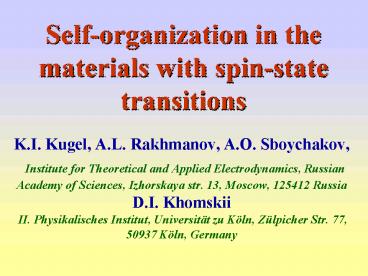Selforganization in the materials with spinstate transitions - PowerPoint PPT Presentation
1 / 18
Title:
Selforganization in the materials with spinstate transitions
Description:
Self-organization in the materials with spin-state transitions ... E(1)-E(2), E(1)-Eloc, E(2)-Eloc are independent of E0 and E1! energy ... – PowerPoint PPT presentation
Number of Views:23
Avg rating:3.0/5.0
Title: Selforganization in the materials with spinstate transitions
1
Self-organization in the materials with
spin-state transitions
- K.I. Kugel, A.L. Rakhmanov, A.O. Sboychakov,
- Institute for Theoretical and Applied
Electrodynamics, Russian Academy of Sciences,
Izhorskaya str. 13, Moscow, 125412 Russia - D.I. Khomskii
- II. Physikalisches Institut, Universität zu
Köln, Zülpicher Str. 77, 50937 Köln, Germany
2
Electronic phase separation as a
self-organization phenomenon
The phase separation phenomena a key issue in
the physics of strongly correlated electron
systems, especially in manganites and related
compounds
The simplest type formation of nanoscale
inhomogeneities such as ferromagnetic metallic
droplets (magnetic polarons or ferrons) located
in an insulating antiferromagnetic matrix
self-trapping of charge carriers
Usually related to an interplay between
different order parameters involving magnetism
ferro vs antiferro, antiferro vs supercond., etc.
Another degree of freedom a competition
between different multiplet states of transition
metal ion in magnetic oxides leading to so called
spin-state transitions
The situation is characteristic of compounds with
Co3 and Fe2 ions Typical example cobaltites
with the perovskite structure such as La1-xCaxCoO3
3
Crystal structure of cobaltites RE1-xAxCoO3
ideal cubic sell, perovskite structure
RELa, Pr, Sm, ACa, Sr, Ba,
4
Electronic configurations of Co3 and Co4 ions
5
Possible ground states of Co3 and Co4 ions (in
the absence of intersite hopping)
1.
2.
3.
Intermediate-spin state is impossible!
6
Charge transfer between Co3 and Co4 (similar
to the double exchange)
Possible hopping terms
-zt
-zt
7
Model Hamiltonian at Dgt3JH (LS-LS case)
ferromagnetic spin alignment
vacuum state
creates a hole at t2g level
creates an electron at eg level
8
One-site Hamiltonian
Effective Hamiltonian for the LS-LS case
Energy
9
Densities of low- and intermeiate-spin Co3
versus doping
A jump-like transition to the state with
A.Sboychakov, K.Kugel, A.Rakhmanov, D.Khomskii,
arXiv0409.4760
10
Energies of homogeneous states versus doping
homogeneous state is unstable at 0 lt x lt x3 !
11
Model Hamiltonian at Dlt2JH (HS-HS case)
ferromagnetic spin alignment
vacuum state
creates an electron at t2g level
creates a hole at eg level
12
Effective Hamiltonian for the HS-HS case
energy
HS-HS case (Dlt2JH ) is similar to LS-LS case
(Dgt3JH) under the following replacement
E(1)-E(2), E(1)-Eloc, E(2)-Eloc are independent
of E0 and E1!
13
Possible homogeneous states. I
1
Parameters of the model
14
Possible homogeneous states. II
15
Phase diagram including phase-separated states. I
16
Phase diagram including phase-separated states. II
17
Phase diagram including phase-separated states.
III
18
Conclusions
- A simplified model of a strongly correlated
electron system with spin-state transitions was
formulated - We demonstrated a tendency to the phase
separation for doped perovskite cobaltites in a
wide range of doping levels. - The phase diagram including large regions of
inhomogeneous states was constructed in the plane
of parameters doping x versus eg-t2g energy
splitting ?. - The form of the phase diagram turns out to be
strongly dependent on the value of the hopping
integral t.































